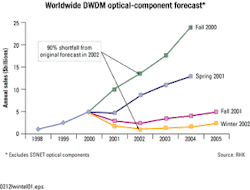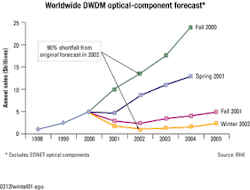Business development matters most
Never in our experience has there been such a divergence in opinions about the future of optical investment. More pessimistic venture capitalists believe that the problems of telecommunications are so deep, so structural, and so long-term that the return of a favorable business climate is many years away. Any new investment now, according to this thinking, will be wasted completely or largely washed out in the next round of financing. More optimistic venture capitalists see good opportunities to invest at the bottom of a cycle, a reasonable upturn by 2004, and opportunities for profitable exits in perhaps 2005 or 2006.
We tend to be in the middle of that spectrum. We remain troubled about seeing no clear exits for our investments and that even the large equipment vendors, companies that might be expected to bottom-feed on cheap, young acquisitions, have not yet felt the confidence to do so. We see no leading indicators that would forecast a telecom upturn and base our relative optimism partly on historical analogy (i.e., good times have always followed bad times). We also expect Internet usage to increase by 50-100% per year and eventually to reinvigorate equipment demand.
At various points in time over the next few years, we expect inventories of optical equipment to run down or become obsolete; network capacity to become exhausted—initially on a link-by-link basis; and the industry to experience an unanticipated jump in demand. Then we'll see capacity shortages and strains on a dramatically downsized supplier base. This resultant jump in demand will probably be neither dramatic nor near-term, but it will signal a sustained optical upturn.
With that expectation, we have made optical investments in two new portfolio companies over the past year-and-a-half and expect to invest in one or more per year during the next few years. All investments so far have been in optical components, which taken as a whole still represent a $2-billion-to-$3-billion market and, with today as a starting point, can expect 20% annual growth rates. That's not so bad! However, we are making our new investments with the recognition that the criteria for successful investment in optical communications have fundamentally changed.
In 1999 and 2000, most of the 200-300 optical-component startups that emerged were based mainly on superior technology. Such projects often found backers, partly because the industry as a whole was receptive to anything that promised to open performance bottlenecks. Many of these startups have now completed their development work and proven their concepts. Now, they are searching in continued high numbers for series B round ramp-ups of $10 million to $15 million that will take them to full production. We think most will fail.
Many of the reasons are all too obvious: the collapse of carrier spending on new technologies, the decimation of carrier and equipment vendor engineering staffs that once might have helped integrate new technologies into existing operations, and the already noted investor pessimism. In such an environment, raising new rounds is a steep uphill climb. But there is another factor that based on the scores of business plans we see is not sufficiently understood by entrepreneurs: In today's environment, market and financial risk are paramount. They far overshadow technology risk as determinants of entrepreneurial success. While most scientist and engineer founders understand that at some level, they often fail to sufficiently transform this understanding into appropriate business plans.
Here then are the new criteria for optical investment we encounter every day, through our dozen-plus existing optical portfolio companies as well as steady dialogue with large equipment vendors and carriers.
The first criterion for judging new technologies is the ability to enable dramatic improvement in customer economics whereby customers can realize those economics in the relatively near term, ideally in current-generation equipment. Performance advantage is of no benefit unless it directly translates into near-term economic advantage. As a rule of thumb, carriers and equipment companies are still willing to spend on new breakthrough technology, but they will do so only when the new technology offers at least five times reduction in capital costs at the systems level, with an associated reduction in operating expense. Moreover, such improvement must be relatively easy for carriers and systems companies to implement with relatively modest nonrecurring-expense requirements. In short, the economics that matter most can be achieved within a short time by the customer and customer's customer.
At the component level, for example, certain advances in monolithic integration and hybrid planar integration appear to be able to overcome the large yield penalties that have handicapped other integration approaches and thus may achieve dramatic cost improvement. At the systems level, advances in network agility will offer dramatic cost savings over fixed, dumb, point-to-point network solutions. They will achieve economic advantage, partly by fulfilling the long-awaited promise of enabling rapid (in hours, not months) network provisioning without multiple truck rolls.
We are also interested in investing in technologies that are true "platforms." The term "platform" unfortunately has become overused and is a standard claim in most optical business plans. Yet, few technologies have the required attributes. A platform technology scales readily to multiple market applications with relatively modest incremental investment. A lot of companies believe they have platform technologies, but the frequent reality is that major investments are required to extend the technology to multiple markets and customize it to meet individual customer needs.The importance of having a scalable platform is greater today because of the collapse of the telecom market, where many vertical-market segments have declined in size by 80-95% from their 2000 peaks. It is very, very hard today to build significant value focusing on one vertical-market segment. Three years ago, there were relatively few competitors; investors will see little value in companies that are one of a dozen competitors going after one shrunken market niche—no matter how superior their technology. There are occasional exceptions, of course. We have invested in one startup (now in "stealth" mode) that does not meet the test of having a true platform technology, but they compensate by addressing a larger vertical market with a unique technology and having unusually strong ties with large tier one customers that need this technology. Which brings us to our next point.
Most fundable optical companies today must come with established customer relationships or at least deep systems or carrier-level understanding. Such relationships and market knowledge are relatively rare among companies at the component or module level, and therefore those few companies that do possess these attributes stand out. A strong relationship with a major vendor—Lucent Technologies, Cisco Systems, Alcatel, Nortel Networks—is far more valuable in some instances than intellectual property. Such relationships give startups the credibility so critical in today's tough environment. Product development strategies with an established partner can also lead to a greater likelihood of commercial success.
Based on our interactions with entrepreneurs, the process of developing a productive business relationship remains an area of great misunderstanding. It is not uncommon for scientists and engineers to put together a slide presentation, visit major customer sites, rejoice in the up-and-down nodding of heads, and conclude that they are on track. Yet, they could not be further from the truth. It requires far more effort to discover what their technology's economic advantage truly is, what initial application makes the most economic sense, what the product's market positioning should be, and confirm all conclusions through iterative customer interaction. Typically, we see 70% of entrepreneurial effort going into technology development when that amount of effort should be going instead into business development.
It is crucial that entrepreneurs develop a capital-efficient model. We are essentially back to the company valuations typical of the early 1990s, with startups completing series A rounds that still leave post-money valuations at no more than seven digits. Such valuations fall some 50% below what they were at the peak of optical investing (and are modest when compared to the 80-90% drops in value of later-round companies). But the lesson is clear: Startups must do more with less. Only business models that permit lower burn rates will gain any traction with investors. Instead of rapid ramp-ups and break even at $50 million in revenue, we're seeing slower ramp-ups and break even at $20 million.
Finally, entrepreneurs need to ensure that from the beginning they attract a syndicate of venture capitalists with deep pockets. In today's environment, it's pretty much all or nothing: No optical company should start a serious launch without backers able to finance the current round, the next round, and, if necessary, all the way to critical mass and exit.
We confront a difficult time for optical innovation. Of the several hundred optical ventures launched over the past four years, we expect only about 10% to survive as standalone companies capable of supporting an initial public offering—should the markets return. Another 20% will survive as acquisitions by larger optical companies but often at lower values than their venture capital backers had invested. Yet, opportunities remain.
Carriers and large equipment vendors know that they must cut costs drastically to grow again and win the favor of Wall Street. They also know they cannot count on the optical equivalent of Moore's law to steadily bring down costs and raise performance. Instead, they must identify the right new optical technologies that promise step function gains. But given their own corporate pressures, they cannot afford to ferret out the best technological answers. So it is incumbent on the optical entrepreneurs to do the economic work for their customers. The few optical startups able to match the best in technology with the best in business sense will win.
Gary Shaffer is a general partner at Morgenthaler Ventures (Menlo Park, CA). Morgenthaler's optical investments include Agility Communications, Cortina Systems, Fiberspace, Ignis Optics, Innovance Networks, InPlane Photonics, NanoOpto, Peregrine Semiconductor, Princeton Lightwave, VSK Photonics, Xponent Photonics, and Zolo Technologies.

